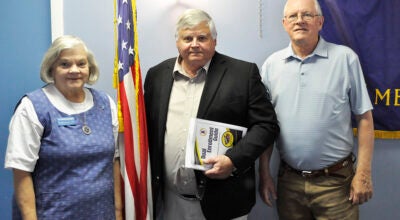Sewer, water rates could increase
Published 12:00 am Friday, September 4, 2009
A potential increase in water and sewer rates doesn’t sound like something Brundidge residents would want to incur.
However, it may be one they have to deal with, at least in the part of the sewer rates.
Polyengineering President and Brundidge consulting engineer Max Mobley presented the Brundidge council with a rate study for both water and sewer at Tuesday’s meeting.
According to Mobley, changes are needed in Brundidge’s sewer rates in order for the city to remain in compliance with EPA regulations concerning the allocation of sewer system operating and maintenance costs.
City Manager Britt Thomas said cities such as Brundidge who received grant money from the EPA are required to recover operations and maintenance costs and adjust their rates accordingly.
That’s just what Mobley proposed.
Mobley’s proposal includes an increase for a standard meter service from $8.60 per month to $10.74 a month.
The proposed increase includes both the debt service recovery component and the per unit operating and maintenance component.
Mobley said the goal of the increase would be to get the sewer on a self-supporting basis, but even with the increase it would not be completely self-sufficient.
“These rates do not put sewer on a self-sustaining basis, but they will come pretty close,” Mobley said.
According to Mobley, these changes combined with significant increases in industrial wastewater loads and flows result in an overall 20 percent increase in sewer revenue.
In 2003, when Brundidge last reviewed its sewer rates, the sewer system did not pay for itself after one of the primary load-bearers closed.
“Sewer did not pay for itself for a long time,” Mobley said. “In the early 1990s, our rates were a little on the high end of the scale.”
According to Thomas, the city didn’t change it’s rates for 17 years.
“In 2003, the city of Brundidge had just completed a major water, sewer, and electrical capital improvements project in connection with the construction of the Wal-Mart Distribution Center,” Mobley said.
With the 2003 study, the rates incurred were supposed to put the sewer and water systems on a self-supporting basis, but several facts played into part.
According to Mobley, the energy costs have increased at rates much higher than the overall rate of inflation- that’s something Brundidge residents know all to well.
“Six years later, there has been a very volatile increase in commodities,” Thomas said. “You use petroleum to make PVC pipe, use steel in water products, and you use gas to do your job required by regulation.”
Also, the mix between industrial and residential customers has changed thus significantly impacting how sewer system operating and maintenance costs are to be allocated.
Large Industries such as Southern Classic Food Group and Supreme Oil South help pay for the sewer, because they produce higher amounts of waste.
Mobley and Thomas discussed at Tuesday’s meeting that Doxee, which was at one time Brundidge’s leading load-bearer, usually exceeded its load, but closed.
But thanks to newer industries such as Southern Classic Food Group and Supreme Oil South, now comprise a larger proportion of the city’s sewer rate structure, and allows the city to recover its operations and maintenance costs.
For example, the current rates are based on loads and flows from 2003. Then the wastewater flows were within 10 percent of what they were in 2008.
“High strength loads that were projected in 2003 have been well beyond what was,” Thomas said.
For example, loads in 2003 averaged 1,246 pounds per day compared to nearly 3,000 pounds per day in 2008.
This is due largely in part from Southern Classic Food Group using around 1,788 pounds per day and Supreme Oil South using about 650 pounds per day.
According to Mobley’s report, since the two food processors are major contributors to the sewer system, they are subject to special high strength charges added to the basic sewer charges all users pay.
These contributions affect the overall operating cost of the system and the charges they pay indirectly affect the rates of all users.
One other component Mobley stated was that the city had been static on the number of customers in the past five years.
A nearly $5 increase in the monthly minimum water rate, might be a difficult thing to swallow, but may be necessary for the city to place the water system on a financially self-sufficient basis, which had been the plan in the current rate structure that was implemented in 2004.
Still, the system is expected to have lost roughly $500,000 by the end of FY 2009 since Oct. 1, 2006.
One reason for this loss, according to Thomas was that the College Street well went out.
“We spent money, you might say really gambling to see if (the well) will last 10-15 more years,” Thomas said. “We didn’t need to repair College Street. We have enough supply at Wal-Mart Distribution and Elm Street. We could have taken that well out of service.”
Thomas said the city wanted to get ahead on its water supply.
As for water, the city made a $4,560 profit in 2006, but saw a $202,489 loss in 2007 and a $247,029 loss in 2008 and is expected to see a $46,370 loss in 2009.
These losses are due to nonrecurring repairs and maintenance, such as the College Street well repairs.
According to Mobley’s plan, A 55 percent rate increase will restore self-sufficiency to the water system and general funds for future capital needs.
This means that the city would increase its monthly minimum charge on single unit standard meters from $8.65 per month to $$13.41 per month, which does not include usage fees.
Usage fees will jump from $1.56 per 1,000 gallons to $2.41 per 1,000 gallons, and this is for the first 100,000 gallons per month.
Mobley told the council that $305,000 is required for general operation and maintenance, $95,000 in allowances for nonrecurring repairs and maintenance, $40,000 for capital improvements, $123,183 for water-related debt service, for a 55 percent increase.
While the city isn’t under any regulations to increase water rates as it is for sewer rates, Thomas said it would get the city up to par .





